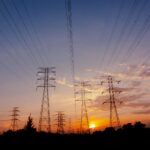Any form of energy which is not derived from fossil fuels falls under the umbrella of alternative energy. This encompasses renewable energy sources like the sun, the wind, and hydroelectric power. A multitude of factors, including concerns about climate change, rising energy prices, and governmental policies that favor the development of renewable energy, are causing the usage of alternative energy to increase quickly around the world. There is a paradigm shift with the thoughts of the world shifting from advancement to sustainability. In 2021, according to the International Energy Agency (IEA), alternative energy sources generated about 28% of global electricity.
When the talk of alternative energy emerges, hydropower is at the forefront. It supplies 17% of the global electricity production as per the 2020 International Energy Agency (IEA) data. In Nepal’s case, hydropower is also the major alternative energy source. Nepal has a hydropower capacity of 83,000 MW, of which about 1200 MW is developed currently. As a substitute for hydroelectricity, Nepal has solar and waste energy which have the potential to fulfill the alternative energy needs of the country.
Nepal has huge potential for diversifying to different sources and exploring the solar and waste market. The country is home to abundant and affordable solar energy resources – the annual solar potential in Nepal is 50,000 terawatt-hours, which is 7,000 times more electricity than the country now uses and 100 times more than its hydropower capacity. Kathmandu Valley alone generates about 1200 tons of municipal solid waste daily. However, issues hindering these technologies must be removed, such as excessive up-front expenditures, a lack of knowledge, poor infrastructure, and unfavorable government regulations. Despite these difficulties, solar and waste energy are becoming more popular in Nepal, with private-sector businesses working to promote them and the government setting ambitious targets for their development. Waste energy can create a sustainable energy backup, reduce greenhouse gases, and be cost-effective over the long term. Solar panel installation or the installation of a waste-to-energy system may be expensive initially, but the savings on energy costs often make up for this.
Scope of Solar Energy
Private sectors have taken the lead in harnessing solar power of solar energy. A prime example of solar power to energy is the Mithila Solar Power Project in Dhalkebar. Sitting on 6.3 hectares of land, the project started in the year 2021 with the cost of the project being NPR 98 crores. It is an on-grid system project, which means any electricity produced is directly joined to the main transmission line. The project has made a deal to sell the electricity to the Nepal Electricity Authority (NEA) for 25 years for NPR. 7.30 per unit.
The capacity of the solar energy plant is 12MW, while it currently generates 10MW of electricity using 28,504 solar panels to capture the sun’s rays. The panel generates 430 watts per panel of electric current. The electricity and the entire plant are controlled from the control center which administers the solar and its output and transmission of line to the Dhalkebar center. The plant has been designed and constructed with environmental sustainability in mind. It uses renewable energy from the sun, reducing greenhouse gas emissions and contributing to the fight against climate change. Additionally, the project has been developed per international environmental and social impact assessment standards to minimize the project’s impact on the local ecosystem and communities.
There are other private sector-led solar projects like Solar PV Pratappur, Bhrikuti Solar Power Project, Solar PV Project Banke, and many more, and some government projects like Block No 1 Solar Farms Project, Block No 2 Solar Farms Project, Grid Connected Solar Project Block 4, Nuwakot in the mix. Solar energy has also been used in projects of cooking foods in rural areas by using solar cookers.
Scope of Waste Energy
Similarly, waste energy is another type of renewable energy that can be recovered from organic materials, such as food waste and sewage. It can be used to generate electricity and heat. Venture Waste to Energy is a leading example of using municipal waste to produce productive goods. Venture Waste to Energy is a private initiative established in 2016 in Dharan but the works were formally started in 2022 due to technical and maintenance issues and the COVID-19 pandemic. The main work of Venture to Waste Energy is to manufacture Compressed Natural Gas (CNG) for organic wastes. 20 to 22 tons of municipal waste are collected from the Dharan municipality to be converted into CNG. CNG gas is currently used for running autos in the Dharan area but increasing the size and scale of production will help them open more avenues like use in households for cooking. The project was constructed at the cost of NPR. 25 crores and is currently employing 40 staff. The project uses inorganic waste for landfills and creates by-products like fertilizers they sell.
Venture Waste to Energy is an important development in the field of waste management and energy production. While it faces some challenges, it has the potential to provide clean energy, reduce waste, and create job opportunities. There are other waste management projects which focus more on the collection and dumping of waste. New waste-to-energy projects are being deployed in the Kathmandu Valley funded by the European Union. Smaller projects on waste energy in Nepal include using gober gas for cooking food in rural areas.
Although the National Renewable Energy Policy, 2074 (2017), and the Alternative Energy Promotion Centre (AEPC) Act, 2051 (1995), for alternative energies like solar and waste, are present, challenges persist. The problem of high up-front costs to set up the project, like buying machines, renting lands, shortages of skilled labor, and the need to bring experts from India, and unfavorable regulatory environment in case of solar and waste specific make it difficult to set up and run alternative energy projects.
Way Forward
Solar and waste are promising alternative sources of energy. Their abundance in the case of Nepal gives us a huge advantage to tap into their capabilities and follow a green economy faster. The government has been overseeing and supporting renewable energy projects through the Alternative Energy Promotion Centre (AEPC). AEPC provides information and awareness about alternative resources, provides financial assistance to promote renewable technologies, and advocates the use of alternative energies. Along with the works of AEPC, alternative energy can be used more by implementing:
- Proper Regulatory Framework: Specific policies regarding solar energy and waste energy to promote alternative energy and create a level playing field for all stakeholders.
- Improved Reach of Education and Training: Increase in demand for the use of alternative energy promoted through education and training to individuals on using solar and waste energies.
- Financial Assistance in Projects and Investment in Research and Development: Providing financial assistance can incentivize making alternative energy affordable to consumers and businesses plus investment in R&D can make alternative energy efficient and accessible.
- Creation of Skilled Workforce: Developing necessary skilled workforce and experts through training so as not to have a dependence on foreign experts.
Thus, promotion and assistance in the alternative sector along with proper regulatory framework will assist in creating an environment to use alternative energy and build towards a sustainable future.
Adarsha Subedi is an Economics undergraduate currently enrolled at Kathmandu University School of Arts. He has a keen interest in international, development economics, public policy, and economic theory. He is an intern at NEF.





